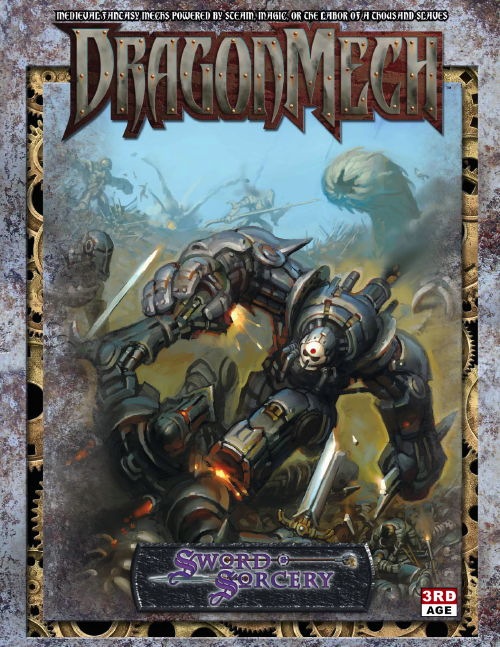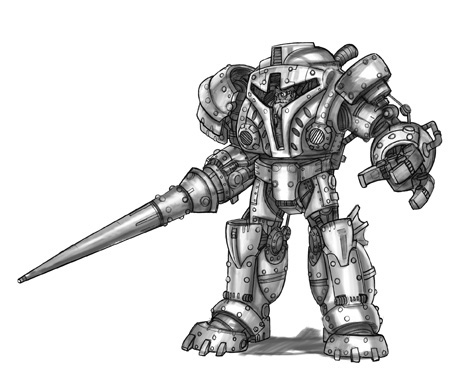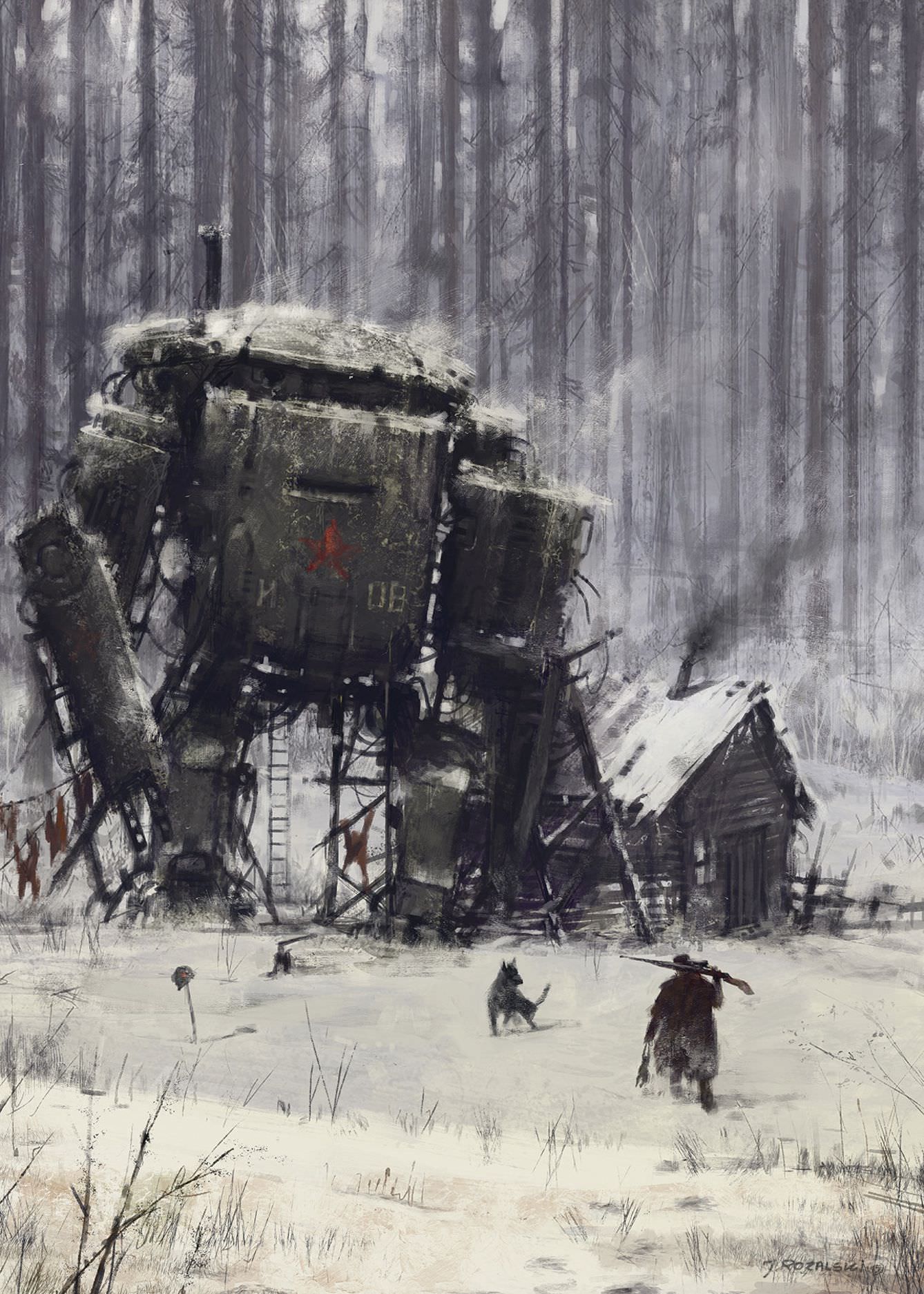
One of my original inspirations for ATWC, especially the Plains of Rust, was Dragonmech: a nearly-forgotten setting published by Goodman Games back in 2004, before the company refocussed its efforts on its much more successful Dungeon Crawl Classics adventure series. Dragonmech was set in a world called Highpoint, which used to be a generic D&D setting... until its moon's orbit started to decay. As the moon came closer and closer, enormous lumps of moon-rock started to get ripped off it by the planet's gravity, pummelling the surface of Highpoint with an endless 'lunar rain' of meteorites which darkened the sky, wrecked the ecosystem, flattened the forests, and basically destroyed all above-ground civilisation. To make matters worse, it turned out that the moon was inhabited by evil, intelligent blob-monsters, who were perfectly capable of surviving a meteorite ride down onto the planet's surface. By the time the moon got close enough for the monstrous Lunar Dragons to start flying down onto Highpoint, the setting was pretty much fucked.
So the dwarves invented steam-powered mecha to fight back. Like you do. And a hundred years later, when the game itself was set, everyone who was anyone was living in giant city-mechs and fighting each other using giant robots with steam cannons on their heads.
I liked a lot of things about Dragonmech - though the D&D 3.5 system was pretty much the worst imaginable fit for it - but I just couldn't get past the inherent implausibility of its setting elements. City-mechs are a nice idea - but if you were going to build an enormous mobile fortress, large enough to be inhabited by thousands of people for years at a time, why would you build it in the shape of a human? (Wouldn't it sink into the earth every time it put its foot down?) In a setting where cannon technology is readily available, why would anyone build a 90' war robot whose main armaments were a giant sword and shield, let alone a 50' mech whose primary attack method was running up to people and biting them? I get the thematic appeal of having orcs build mecha powered by slave labour rather than steam engines, but the idea of a bunch of slaves being able to generate enough muscle-power to move not just themselves and the giant metal box they're all sitting in, but also the arms and legs and head and weapons attached to it - and move it not just briefly, but for hours at a time - is ludicrous. And where were the inhabitants of this blasted, post-apocalyptic world getting the iron and coal and water they needed to build and power all these thousand-ton war machines in the first place?
You can get away with this kind of thing in fiction, but not in RPGs. Player characters are devious little beasts: they'll spot the massive impracticality of steam-powered mecha in no time, wrecking the plausibility of the setting in the process. ('Are we really the first people to just build tanks instead?') As a result, when I sketched out the steam-and-clockwork mecha for ATWC, I took a much more conservative approach, keeping them in the 10' to 20' range where they might semi-plausibly occupy a kind of 'super-heavy infantry' battlefield role. After picking up some Dragonmech pdfs in the recent Goodman Games online sale, however, I've been wondering if I may have been a bit too conservative. Maybe clockpunk mecha could have roles other than 'big stompy robot' after all...
So here's a few more, most of which blur the boundaries between mecha, tanks, and yagas. The numbers refer to the technology rules, which can be found here.
Name
|
Operate (O)
|
Maintain (M)
|
Repair (R)
|
Construct (C)
|
Runner mech (2-man)
|
2
|
2
|
3
|
3
|
Walking cannon (3-man)
|
2
|
3
|
3
|
4
|
Troop Carrier
|
3
|
3
|
4
|
4
|
Mech-killer (1-man)
|
3
|
4
|
4
|
5
|
Anti-personnel mech (1-man)
|
3
|
4
|
4
|
5
|
Huge mech (8-man)
|
5
|
5
|
6
|
6
|
Iron Crab
|
5
|
6
|
6
|
7
|
Runner Mech (2-man): Whereas most mecha are built for durability, runners are built for speed. They consist of a pair of birdlike metal legs, 10' in height, surmounted by a metal box containing an engine, from which an exhaust pipe emerges like a tail. On top of the engine is a cockpit set with viewing windows, within which the pilot sits, controlling the legs with a pair of levers. (Basically, imagine a more graceful-looking AT-ST walker.) A swivel gun is usually attached to the roof on a turntable, along with a second crewman who acts as a spotter and gunner, and who must be strapped in place to avoid falling off when the mech starts running. Access to the cockpit is via a ropeladder dropped down from above.
Runner mechs are much faster than other mecha, and are the only vehicles of their kind able to keep up with horses - although they have to stop regularly to refuel, as carrying large quantities of heavy coal around would defeat the purpose of their lightweight design. They are the only kind of mech likely to be useful during cavalry engagements, and can also be used as secure, high-speed messengers. They have AC 18 and 25 HP, and are impervious to arrow- and musket-fire, though the roof gunner has no protection except speed and range.
Runner mechs are much faster than other mecha, and are the only vehicles of their kind able to keep up with horses - although they have to stop regularly to refuel, as carrying large quantities of heavy coal around would defeat the purpose of their lightweight design. They are the only kind of mech likely to be useful during cavalry engagements, and can also be used as secure, high-speed messengers. They have AC 18 and 25 HP, and are impervious to arrow- and musket-fire, though the roof gunner has no protection except speed and range.
Walking Cannon (3-man): Pretty much what it sounds like: a metal box on six crab-like legs, with a chimney on top and a cannon sticking out of one end. Inside sit three crew, in cramped and hellish conditions: one to feed the furnace, one to control the legs, and one to load, aim, and fire the cannon. Accuracy and rate of fire are very poor, especially when the walking cannon is in motion, and the only reason to use one instead of a tank is if you need to move your guns across uneven terrain. Proof against ranged weapons smaller than cannons, though if it gets swarmed by infantry then the crew will all get killed by people shooting pistols and stabbing spears in through the viewing slits.
Troop Carrier: Essentially a militarised yaga: a big, oblong metal box, walking along on four stompy legs, one on each corner. Swivel guns are mounted on each side. Has a crew of six - one fireman, one pilot, and four gunners - and can carry an additional six people inside, who can deploy via hatches on its underside, making it a useful way of safely carrying squads of specialists such as sappers across a battlefield. Using legs instead of treads means it has to be less heavily armoured than a large tank would be, and the legs are an obvious weak point, with AC 18 and 20 HP each. Immune to missile weapons smaller than swivel guns.
 |
| Image by Jeff Carlisle. |
Mech-Killer (1-man): A specialised mech meant for battling other mecha. Like a regular small mech, this is a 10' walker operated by a single pilot, who controls its arms and legs with their own: but instead of a normal weapon, its right forearm contains a pneumatic spike powered by pressurised steam, while its left contains a mass of thick chains ending in heavy hooks. In battle the chains pour out through its left palm, and are used for entangling the arms and legs of enemy mecha, allowing the right hand to get within grabbing range: then, once the right palm is pressed against the body of the enemy mech, the pneumatic spike is triggered, hopefully punching through its armour and impaling something important like the engine or the pilot. (The spike is a bit of a one-shot weapon, though: once it's fired, it'll take ten rounds for it to build up enough steam for another shot.) Against non-armoured targets, they can just be used as a giant flail and spear, respectively.
The mech-killer has AC 20 and 40 HP: its chains inflict 1d10+6 damage if used against living targets, or entanglement if used against small- or medium-sized mecha, while its pneumatic spike inflicts 2d8+6 damage and ignores 6 points of armour. (If it's just being used as a regular spike, without the pressurised steam, it just inflicts 1d8+6 and has no special armour-penetration abilities.) If the pneumatic spike scores a hit on a small or medium mech, there is a 50% chance that it deals damage to one of the crew inside, as well.
The mech-killer has AC 20 and 40 HP: its chains inflict 1d10+6 damage if used against living targets, or entanglement if used against small- or medium-sized mecha, while its pneumatic spike inflicts 2d8+6 damage and ignores 6 points of armour. (If it's just being used as a regular spike, without the pressurised steam, it just inflicts 1d8+6 and has no special armour-penetration abilities.) If the pneumatic spike scores a hit on a small or medium mech, there is a 50% chance that it deals damage to one of the crew inside, as well.
Anti-Personnel Mech (1-man): Mecha exist, and chatterswords exist, so it was only a matter of time before someone put them together. This is your classic 'ten-foot robot with giant chainsaws for hands', with the chatterswords drawing power from the mech's mainspring and thus not requiring the regular rewindings needed by hand-held versions. Having chainsaws for hands means that it can't actually interact with the world except by chainsawing holes in it. Have fun with that.
Anti-personnel mecha have AC 20 and 40 HP. Their giant chainsaw hands inflict 3d6+6 damage on targets made of soft, squishy flesh. Any attack roll of 1 means that the teeth have snapped off, and the hand is now just a big club (1d8+6 damage) until it is repaired. Using them on heavily armoured targets (e.g. tanks, other mecha) caused their teeth to snap automatically.
Huge Mech (8-man): A boxy metal robot about 25' tall and weighing a couple of hundred tons, supported by huge legs that terminate in the massive splayed-out feet needed to support its enormous weight. A row of three cannons are mounted across its wide metal shoulders. The arms are mostly just there for show, but can be used to knock aside obstacles or punch giant monsters in the face when necessary. Has a crew of eight: three gunners to operate the cannons, one to control each arm, one to control the legs, one to operate the engines, and one to feed the furnace. Very slow, very ponderous, and almost indestructible. Just run away until it runs out of coal. It will run out of coal.
Anti-personnel mecha have AC 20 and 40 HP. Their giant chainsaw hands inflict 3d6+6 damage on targets made of soft, squishy flesh. Any attack roll of 1 means that the teeth have snapped off, and the hand is now just a big club (1d8+6 damage) until it is repaired. Using them on heavily armoured targets (e.g. tanks, other mecha) caused their teeth to snap automatically.
 |
| Image by Jakub Rozalski. |
Iron Crab: Yagas larger than the 15' cube size are impractical, given their tendency to sink into the ground with each step. This is an attempted solution: an armoured metal dome, 20' high and 30' across, bristling with swivel guns and supported on six articulated metal crab-legs that raise it 8' off the ground. Internally, the crab is subdivided into twelve small rooms which may be outfitted as the owner desires, allowing it to be used as a secure mobile base of operations by as many as eighteen people - or more, if some of them don't mind riding on the shell. Very few of these exist, mostly as roving temple-forts for the Steel Aspirants, and they are not really intended for battlefield use.


Ah man, Dragonmech was great! Some of the smaller man-powered mechs were cool, although it's still probably easier to just get some horses.
ReplyDeleteYeah, the smaller ones were the least impractical. The bigger ones all seemed to have been written by people with no sense of scale. I still have a soft spot for the tribes of feral halflings living in the gear forests, though.
DeleteI think they'd have had an easier time of it if they'd gone full science fantasy/magitech rather than steampunk. Although for a more grounded setting you might be able to get some similar effects with a mech that's only partially man-powered, like there are a few key parts that need to be hand-cranked. And I think you've got people living inside of an immobile giant robot, so you could probably make one a little bigger and get weird short people living in the gears.
DeleteYou mean the Rust Tribes and their half-functional God Soldier? I imagine it as being castle-sized rather than city-sized, so I struggle to imagine a whole feral clan living in the gears. (Still better than that one Dragonmech book which had coglings living in the gear forests of a 110' Terror Tower, though, which would be like having an undiscovered tribe living in the basement of your apartment building.) But, yeah, I'm sure I can find a role for a cogling-analogue somewhere in the setting. Some rusting and abandoned factory-city someplace, maybe...
DeleteTo pull it off with the god soldier I was imagining you'd have to make the whole tribe that lives inside of it clannish and strange, rather than splitting it up into normals and coglings (although a single Ben Gunn or Quasimodo guy hanging out up there could work too). Abandoned factory-city seems like a good adventuring site though!
DeleteWhy limit yourself to tanks? Isn't Fly a simple enough (i.e. low level) spell that can be permanently added, thus make flying fortresses?
ReplyDeleteAnd I don't know if the Lyre of Building is found within the Wicked City, but if it is, watch the yagas fly off the assembly lines.
ATWC doesn't assume any regular D&D-style magic at all. If you have commonplace D&D magic and actually try to follow through on the setting implications, then your world will get very weird very quickly.
DeleteIt does have a flying castle, though, in the form of the cloud castle that the Wicked King stole from the Blue Folk:
http://udan-adan.blogspot.co.uk/2015/09/foes-of-wicked-city-6-blue-folk.html